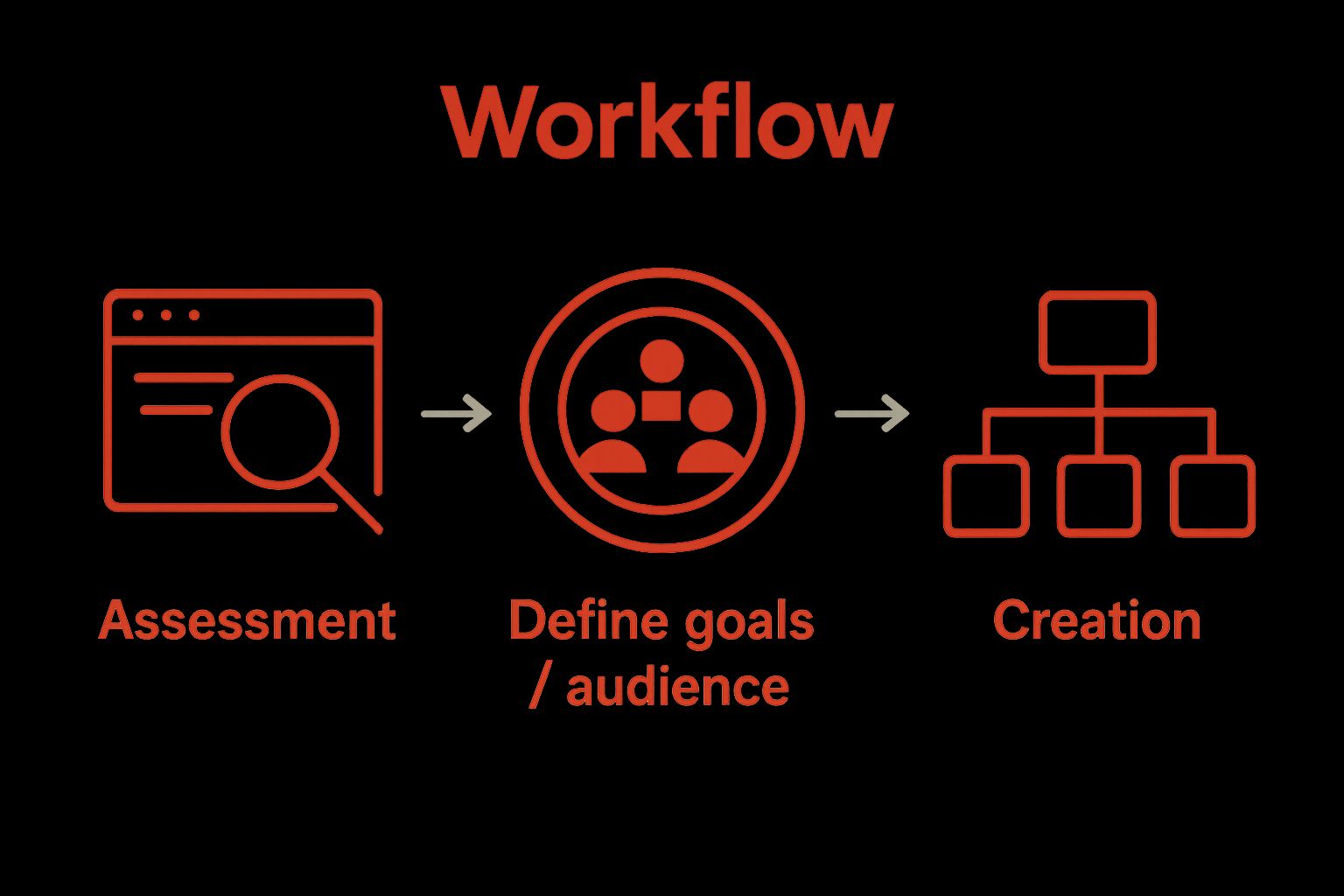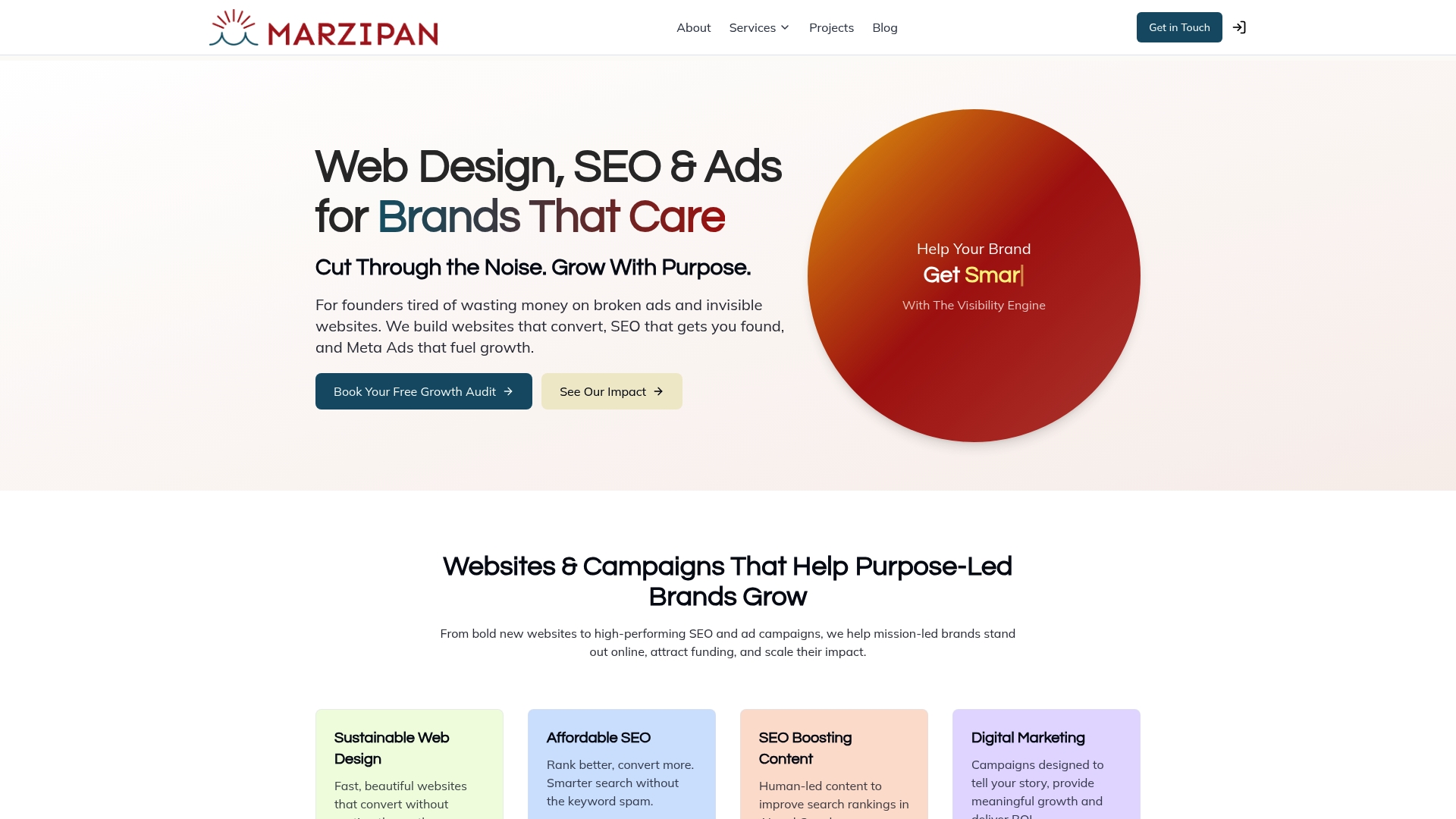Essential Website Redesign Steps for Success in Sydney
Redesigning a website can feel overwhelming, especially in a city where over 85 percent of Sydney businesses see measurable growth after a strategic site overhaul. That sounds impressive, right? Yet the biggest wins rarely come from a flashy new homepage or trendy graphics. True digital impact starts way before you lift a finger on design software, and lies in the quiet details of understanding your users, mapping your goals, and planning every move with care.
Table of Contents
- Assess Current Website Performance
- Define Goals And Target Audience
- Create A Detailed Sitemap
- Design Visual Mockups And User Experience
- Develop, Test, And Launch The Redesigned Site
- Evaluate Performance And Gather Feedback
Quick Summary
| Key Point | Explanation |
|---|---|
| 1. Assess Current Website Performance | Conduct a thorough audit to identify strengths and weaknesses before redesigning your site. |
| 2. Define Clear Goals and Audience | Establish specific objectives and understand user needs to guide design decisions effectively. |
| 3. Develop a Comprehensive Sitemap | Create an organised structure that enhances user navigation and aligns with project goals. |
| 4. Design Accessible and Engaging Visual Mockups | Focus on user-friendly designs that reflect your brand and ensure ease of access for all users. |
| 5. Implement Continuous Evaluation Post-launch | Use analytics and user feedback to make ongoing improvements that maintain site effectiveness and user satisfaction. |
Assess Current Website Performance
Before embarking on a website redesign journey, understanding your current website’s performance is crucial. This foundational step provides insights into what works, what needs improvement, and how to strategically approach your redesign in Sydney’s competitive digital landscape.
Begin by conducting a comprehensive website audit using powerful analytics tools. Google Analytics offers an excellent starting point for measuring key performance indicators. Look closely at metrics like page load speed, bounce rates, user engagement, and conversion rates. These numbers reveal how visitors currently interact with your website and highlight potential areas for enhancement.
Your performance assessment should integrate both quantitative and qualitative data. While analytics provide numerical insights, user experience testing offers nuanced understanding. Gather feedback from actual website visitors through surveys, heatmap tools like Hotjar, and direct user interviews. Pay special attention to navigation challenges, content clarity, and overall site responsiveness.
Learn more about our free SEO audit tool that can streamline this assessment process. The tool helps identify technical performance issues that might not be immediately apparent through standard analytics platforms.
Consider examining these critical performance benchmarks:
- Mobile responsiveness and cross device compatibility
- Search engine ranking performance
- Conversion rate for key user actions
- Content engagement metrics
Remember that a thorough performance assessment is not about criticising your existing website, but understanding its current strengths and opportunities for strategic improvement. By meticulously documenting your findings, you create a robust foundation for your upcoming redesign process.
Below is a checklist table to help you systematically verify each key area during your website redesign process.
| Area to Check | Required Action | Verification Method |
|---|---|---|
| Mobile Responsiveness | Ensure the site is accessible on all devices | Test on multiple screen sizes and devices |
| Content Clarity | Confirm text is easy to read and relevant | Review for clarity and run user testing |
| Navigation | Validate logical structure and ease of access | Use site maps and user feedback |
| Page Load Speed | Check for fast page loading times | Use tools like Google Analytics or PageSpeed Insights |
| SEO Performance | Optimise for search engines | Conduct SEO audits and monitor rankings |
| Accessibility | Meet inclusive design standards | Verify against Web Accessibility Initiative guidelines |
| Conversion Pathways | Ensure user journey supports business goals | Test forms and calls to action with users |
| Security Protocols | Protect user data and site integrity | Review SSL certificates and privacy measures |

Define Goals and Target Audience
Transitioning from performance assessment to strategic planning requires clear definition of your website redesign objectives and understanding your target audience. This critical phase transforms your data insights into actionable design direction for your Sydney based digital project.
Start by articulating precise website goals that align with your broader business strategy. These goals should be specific, measurable outcomes such as increasing online enquiries, improving user engagement, or enhancing brand perception. For mission led businesses, goals often extend beyond pure commercial metrics to include community impact, sustainability messaging, and meaningful user interactions.
Explore our sustainable web design approach which emphasises purpose driven digital experiences. Effective goal setting requires understanding not just what you want to achieve, but why those outcomes matter to your organisation and audience.
Crafting a detailed audience persona becomes your next strategic priority. Move beyond demographic data to understand psychological motivations, digital behaviour patterns, and specific challenges your target users experience. Consider conducting stakeholder interviews, analysing competitor audiences, and reviewing your existing customer data to build comprehensive user profiles.
Your audience research should uncover key insights like:
- Primary age ranges and professional backgrounds
- Digital literacy and technology preferences
- Typical online search and purchasing behaviours
- Specific pain points your website can address
By synthesising performance metrics from your previous assessment with these audience insights, you create a robust foundation for designing a website that genuinely serves user needs. The intersection of clear organisational goals and deep user understanding will guide every subsequent design decision in your website redesign process.
Here is a summary table of essential audience persona insights to guide user-focused website redesign decisions.
| Insight Area | What to Research | Purpose |
|---|---|---|
| Age Range & Profession | Identify predominant age groups and job roles | Tailor content and visuals for target demographic |
| Digital Literacy | Gauge comfort with technology and online platforms | Design navigation appropriate for users’ skill level |
| Digital Behaviour | Analyse browsing, search, and purchasing habits | Structure journeys that match user expectations |
| Technology Preferences | Discover preferred devices and software | Optimise for platforms users frequent most |
| Pain Points | Identify challenges or frustrations users face | Address these barriers through design and features |
Create a Detailed Sitemap
With your goals and audience clearly defined, the next crucial step in website redesign is developing a comprehensive sitemap. A sitemap serves as the architectural blueprint of your digital platform, mapping out how content will be structured and interconnected to support user journeys and organisational objectives.
Visual mapping tools can transform this process from abstract concept to concrete strategy. Platforms like Figma, Lucidchart, or even simple mind mapping software provide robust environments for drafting your website architecture. Begin by listing all existing pages and identifying potential new content sections that align with your previously established goals and audience needs.
Check our website carbon footprint tool to ensure your new sitemap considers sustainable web design principles. An efficient sitemap not only improves user navigation but can also contribute to reduced digital energy consumption.
Consider your sitemap as more than a technical document. It represents a strategic communication tool that reflects how users will experience your digital ecosystem. Prioritise logical content hierarchies that guide visitors intuitively through information, ensuring each page serves a clear purpose and connects meaningfully to the broader user journey.
Your sitemap should encompass these critical considerations:
- Clear hierarchical content organisation
- Logical navigation pathways
- Strategic content placement
- Seamless user experience flow
During development, conduct multiple review cycles with key stakeholders. Test the proposed structure against your initial audience research, verifying that the proposed navigation matches user expectations and behaviour patterns. A well constructed sitemap anticipates user needs, reducing friction and supporting intuitive exploration of your digital platform.
Design Visual Mockups and User Experience
Transitioning from your sitemap, the visual mockup phase transforms structural planning into a tangible design narrative. This crucial stage bridges conceptual strategy with actual user interaction, creating a visual representation of your website that communicates your brand’s digital personality.
Begin by selecting design tools that support collaborative and iterative processes. Figma and Adobe XD offer powerful platforms for creating high fidelity mockups that capture both aesthetic appeal and functional requirements. Focus on developing responsive designs that seamlessly adapt across mobile, tablet, and desktop environments, ensuring a consistent user experience regardless of device.
Learn about different web design approaches to inform your visual strategy. Your mockups should reflect not just visual attractiveness, but also align with your previously established goals and audience insights.
Accessibility becomes paramount during this design phase. According to Web Accessibility Initiative guidelines, mockups must prioritise inclusive design principles. Consider colour contrast, typography readability, and navigation simplicity to create an experience that welcomes all users, regardless of their technological capabilities or potential disabilities.
Your design approach should emphasise:
- Consistent visual hierarchy
- Intuitive navigation elements
- Clear call to action placements
- Brand personality expression
Create multiple design iterations and conduct user testing to validate your mockups. Invite potential users to interact with prototype versions, gathering feedback on visual appeal, ease of navigation, and overall user experience. This iterative process allows you to refine designs before full development, saving time and resources while ensuring your final website meets user expectations.

Develop, Test, and Launch the Redesigned Site
With comprehensive mockups and strategic planning complete, the development phase transforms your design vision into a functional digital platform. This critical stage requires meticulous attention to technical execution, ensuring your website not only looks exceptional but performs seamlessly across all user touchpoints.
Responsive development becomes paramount, translating your design mockups into clean, efficient code. Work closely with developers who understand modern web technologies and can implement your visual concepts with precision. Prioritise frameworks and coding practices that support fast loading times, mobile responsiveness, and robust cross browser compatibility.
Explore our free SEO audit tool to validate technical performance during development. Comprehensive testing goes beyond visual verification, examining site speed, security protocols, and overall user experience functionality.
Implement rigorous testing protocols that simulate diverse user scenarios. Conduct thorough cross device and cross browser examinations, verifying that every interactive element functions correctly. Pay special attention to form submissions, navigation menus, and dynamic content loading. User acceptance testing should involve representatives from your target audience, gathering real world feedback before full site launch.
Your development and testing checklist should include:
- Complete functionality across mobile and desktop platforms
- Optimal page loading performance
- Secure data handling mechanisms
- Accessibility compliance
Prepare a strategic launch plan that minimises potential disruptions. Consider soft launching with limited user groups, allowing controlled exposure and immediate feedback collection. Monitor site performance closely during initial deployment, being prepared to make rapid adjustments. A thoughtful, measured approach ensures your website redesign delivers a polished, professional digital experience that meets your original strategic objectives.
Evaluate Performance and Gather Feedback
Post launch, your website redesign enters a critical monitoring phase where continuous evaluation becomes key to long term digital success. This stage transforms your initial website project from a static deliverable into a dynamic, evolving digital platform that responds intelligently to user interactions and organisational goals.
Analytics tools provide the foundational insights for performance assessment. Google Analytics offers comprehensive metrics tracking user behaviour, engagement rates, conversion pathways, and potential interaction bottlenecks. Focus on understanding not just raw numbers, but the qualitative user experience they represent. Examine metrics like average time on page, bounce rates, and user flow to identify areas requiring potential refinement.
Learn about our sustainable web design approach that emphasises ongoing performance optimisation. Gathering structured user feedback becomes equally crucial during this evaluation process. Implement multiple feedback collection mechanisms such as on site surveys, email questionnaires, and direct user interviews to capture nuanced insights about the redesigned website’s effectiveness.
Consider implementing advanced tracking methods that provide deeper user experience understanding:
- Heat mapping technologies
- User session recordings
- Conversion funnel analysis
- Accessibility compliance monitoring
Develop a systematic approach to interpreting feedback, categorising insights into actionable improvement areas. Prioritise changes that directly impact user experience and align with your original website redesign objectives. Remember that website optimization is an iterative process requiring continuous attention and strategic refinement. By maintaining an adaptive mindset, you ensure your digital platform remains responsive, engaging, and aligned with evolving user expectations and technological standards.
Redesign With Confidence: Let Your Sydney Website Stand Out
Tired of feeling stuck with a slow, hard-to-navigate website that does not get results for your business? You have already started addressing critical issues like poor mobile responsiveness, weak user engagement, or unclear user journeys in your redesign research. Now, it is time to transform those insights into a sustainable website solution that works for your mission-led organisation.

Do not let your next digital project fall short of expectations. Discover how our team at Marzipan can support your entire website transformation, from detailed performance audits and accessible design, to purpose-driven SEO strategies. Start today by getting a no-obligation review using our free SEO audit tool, and see why so many Sydney businesses trust us for results that last. Act now to build a website that truly reflects your vision and delivers measurable impact. Visit Marzipan Sustainable Web Solutions and set your redesign in motion.
Frequently Asked Questions
What are the first steps to assess my current website performance?
To assess your current website performance, start by conducting a comprehensive audit using analytics tools. Measure key metrics like page load speed, bounce rates, and user engagement to identify areas for improvement.
How can I define clear goals for my website redesign?
Define clear goals by aligning them with your broader business strategy and specifying measurable outcomes. For example, aim to increase online inquiries by 25% within six months post-launch.
What should I include in my website’s sitemap?
Your website’s sitemap should include a clear hierarchy of content, logical navigation pathways, and strategic content placement to enhance user experience. Create categories that support your defined goals and audience needs.
How do I create effective visual mockups for my website redesign?
Create effective visual mockups by using design tools that allow for collaborative iterations, ensuring your designs capture both aesthetics and user functionality. Focus on maintaining a consistent visual hierarchy and clear call-to-action placements.
What are the best practices for testing my redesigned website?
Testing your redesigned website should include cross-device and cross-browser functionality checks, ensuring a seamless user experience. Implement user acceptance testing with real users to gather feedback and make necessary adjustments before launching.
How can I evaluate my website’s performance after the redesign?
Evaluate your website’s performance post-launch by tracking user behaviour and engagement rates using analytics tools. Conduct user feedback collections to identify areas needing improvement and aim to implement changes that boost user interaction by 15% within three months.







